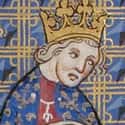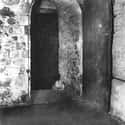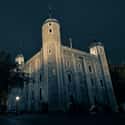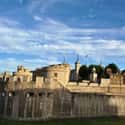-
(#12) Prisoners Were Hung By Manacles And Iron Fetters
Jesuit priest John Gerard described how torture at the Tower took place using manacles and iron fetters. Once Gerard was led to the dungeon, he was asked to renounce Catholicism. When he refused, the unimaginable happened. He was soon led to a pillar where ascended three wicker stairs.
His "arms were then lifted up and an iron bar was passed through the rings of one gauntlet, then through the staple and rings to the second gauntlet. This done, they fastened the bar with a pin to prevent it from slipping, and then, removing the wicker steps one by one from under my feet, they left me hanging by my hands and arms fastened above my head. The tips of my toes, however, still touched the ground, and they had to dig the earth away from under them. They had hung me up from the highest staple in the pillar...."
-
(#7) Prisoners Brought Their Servants Along For Incarceration
Ranulf Flambard brought his servants with him as did Anne Boleyn, King John II of France, John Balliol, and other noteworthy prisoners. Anne Boleyn spent her final days in the same apartments at the Tower where she had waited to be crowned queen three years early. During her time there in 1536, she had servants attending to her every need.
Centuries earlier, Scottish King John Baliol had brought servants with him when he was confined at the Tower. He also had his wife and hunting dogs with him, too. During the Hundred Years' War, King John II of France was held at the Tower with full royal privileges. John had a full group of attendants at his disposal while in confinement as well as when he was allowed to travel around England.
-
(#9) Prisoners Were Forced In To Incredibly Small Spaces As A Method Of Torture
Little Ease is a small area below the White Tower, just under 4 square feet, where prisoners were kept intentionally uncomfortable. There was not enough room to sit, lay down, stand up, or position oneself into anything resembling a comfortable position. The cell was completely black and prisoners were kept in solitary confinement for days on end.
Guy Fawkes was one of the many prisoners subjected to Little Ease, the cramped cell in the dregs of the Tower. So, too, was Jesuit Edmund Campion, who was later put on the rack three times. The Bishop of London later used the term "Little Ease" to refer to where he placed religious heretics, but his prison does not seem to have truly matched the one at the Tower.
-
(#6) Conjugal Visits May Have Been An Option
During his long imprisonment at the Tower of London, Sir Walter Raleigh may have fathered one of his children, an indication that sex wasn't off limits during one's time in prison.
Raleigh's wife, Bessy, had served as one of Queen Elizabeth's maids, but after the monarch learned of Ralegh's secret marriage to Bessy, Elizabeth had them both thrown into the Tower. This imprisonment only lasted a few months and Raleigh later bought their freedom, but when James I accused him and Raleigh of treason in 1603, Raleigh returned to confinement. The next year, Carew, Raleigh's son born while Raleigh was in captivity, by some accounts in the Tower. Carew was christened at the Tower of London as well.
-
(#2) Getting Guards Drunk Was An Effective Diversion For Escape
The first prisoner, Ranulf Flambard, was allowed to bring in the best wines and hold large feasts and decided to use this to his advantage. He wined and dined his guards and used the occasion to discretely bring in a rope hidden in a wine cask.
After a long evening of food and drink, as the guards were appropriately drunk, Flambard was able to escape. According to legend, he lowered himself from the window of the Tower to associates waiting below with horses. Flambard and his accomplices fled England for Normandy where Flambard became Duke Robert's chief advisor. He later led Robert's military on an attempt to invade England but the efforts proved unsuccessful. Flambard was able to reconcile with Henry in 1101 and was restored to his former position at Durham.
When Jacobite William Maxwell was imprisoned in the Tower of London during the early 18th century, he - and his wife - used booze to distract his guards. Lady Winifred Maxwell made the trip to London from their home in Scotland to ask the king for clemency for her husband. King George refused, so when Lady Maxwell, her maid, and two others visited William the night before he was to be executed, they distracted the guards with alcohol and women. While the guards were otherwise engaged, Lady Maxwell shaved her husband's beard and dressed him in women's clothing they had brought in. William and Winifred Maxwell escaped the Tower together and were later spirited out of England.
-
(#14) Henry III Used The Tower To Imprison Alleged Murderers
The Tower was used again as a prison, albeit a temporary one, during the reign of Henry III (k. 1216-1272). Henry III expanded the Tower of London, adding defensive walls and other buildings. He also made it his primary residence but the conditions for prisoners did not reflect any preference. Using the Tower to keep trouble at bay, Henry brought a group of Jews accused of killing Hugh of Lincoln to the Tower in 1255. Out of the 100 Jews imprisoned, 18 were later hanged.
Edward I (k. 1272-1307) followed suit and imprisoned almost 700 Jews at the Tower in 1278 for alleged coin-clipping offenses. Three hundred of the prisoners were later executed.
There were also several times when Jews took refuge in the Tower of London over the course of the 13th century. In the face of rising anti-Semitic feelings in England, Jews sought safety behind its thick walls. Edward I expelled Jews from England in 1290.
New Random Displays Display All By Ranking
About This Tool
Although its name is "Tower of London", it is not a tower, but a complex of buildings, standing on the Thames River, looking like a castle. In history, the Tower of London has been used as a fortress, an armory, a mint, a refuge, etc. The most important use is the highest-level national prison. The Tower of London was built in the 1880s, and many kings expanded and rebuilt it. The most famous historical event in the Tower of London is that the two queens of Henry VIII were imprisoned there and executed secretly. Mary I also imprisoned his sister Elizabeth there.
No one can escape from such a heavily guarded prison. For a long time, people were scared to talk about the Tower of London. The random tool shares 14 details about the Tower of London.
Our data comes from Ranker, If you want to participate in the ranking of items displayed on this page, please click here.
















